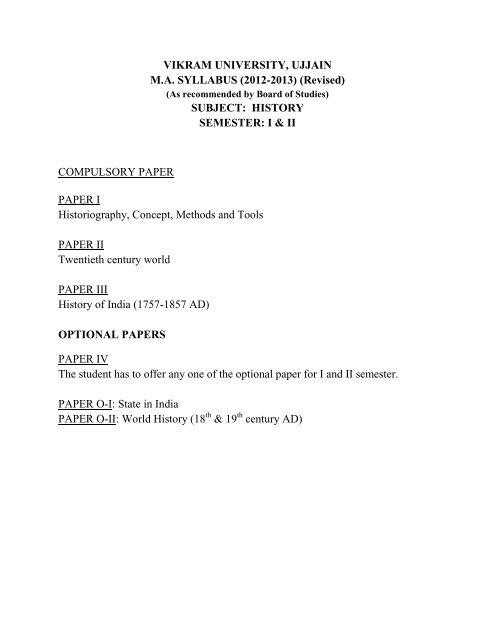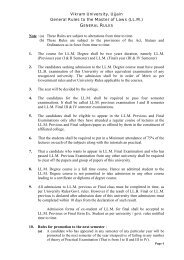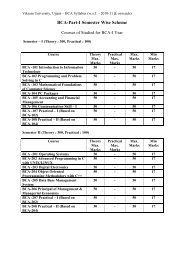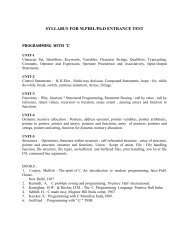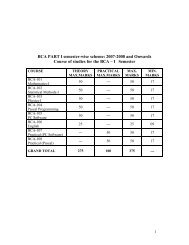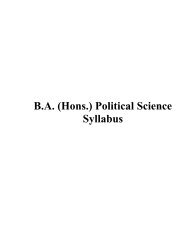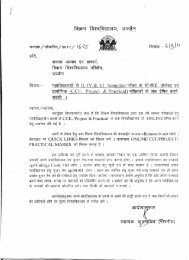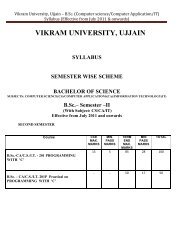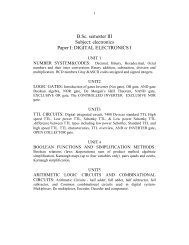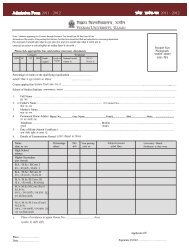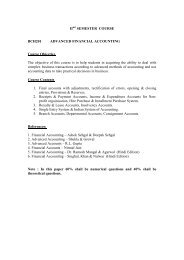VIKRAM UNIVERSITY, UJJAIN M.A. SYLLABUS (2012-2013 ...
VIKRAM UNIVERSITY, UJJAIN M.A. SYLLABUS (2012-2013 ...
VIKRAM UNIVERSITY, UJJAIN M.A. SYLLABUS (2012-2013 ...
You also want an ePaper? Increase the reach of your titles
YUMPU automatically turns print PDFs into web optimized ePapers that Google loves.
<strong>VIKRAM</strong> <strong>UNIVERSITY</strong>, <strong>UJJAIN</strong>M.A. <strong>SYLLABUS</strong> (<strong>2012</strong>-<strong>2013</strong>) (Revised)(As recommended by Board of Studies)SUBJECT: HISTORYSEMESTER: I & IICOMPULSORY PAPERPAPER IHistoriography, Concept, Methods and ToolsPAPER IITwentieth century worldPAPER IIIHistory of India (1757-1857 AD)OPTIONAL PAPERSPAPER IVThe student has to offer any one of the optional paper for I and II semester.PAPER O-I: State in IndiaPAPER O-II: World History (18 th & 19 th century AD)
<strong>VIKRAM</strong> <strong>UNIVERSITY</strong>, <strong>UJJAIN</strong>M.A. <strong>SYLLABUS</strong> (<strong>2012</strong>-<strong>2013</strong>) (Revised)(As recommended by Board of Studies)SUBJECT: HISTORYSEMESTER: IClass /M.A.Semester /ISubject / f HistoryTitle of Subject GroupHistoriography,Concepts, Methods and toolsPaper No. /P-ICompulsory / Optional / : /CompulsoryMax. Marks 40Particulars /Unit-1Meaning and Scope of History: Collection and selection of the data, evidence and itstransmission; Causation; HistoricismUnit-2History and other Discipline-Archaeology; Geography; Anthropology; Natural Applies Sciencesand LiteratureUnit-3Traditions in Historical Writing-Greco-Roman traditions; Chinese traditions; Ancient Indiantradition of Historiography; Baan Bhatt and Kalhan Historiographuy.Unit-4Medieval Indian Historiography, problems of Historiography in medieval India. Main features ofHistorigraphy of Minahj Siraj “u” d-Din Bahrain, Abdul Qadir Bada’ uni.Unit-5Modern trends of Historiography – Positivst, Whig, Classical Marxist and Annals.
<strong>VIKRAM</strong> <strong>UNIVERSITY</strong>, <strong>UJJAIN</strong>M.A. <strong>SYLLABUS</strong> (<strong>2012</strong>-<strong>2013</strong>) (Revised)(As recommended by Board of Studies)SUBJECT: HISTORYSEMESTER: IIClass /M.A.Semester /IISubject / f HistoryTitle of Subject GroupHistoriography,Concepts, Methods and toolsPaper No. /P-ICompulsory / Optional / : /CompulsoryMax. Marks 40Particulars /Unit-1 Approaches to history – Theological; Imperialist; Nationalist; Marxist; Subaltern and Post –Modernist.Unit-2Themes in Indian History – Economics; labor and peasants; religion; Culture; Environment andscience and technology.Unit-3Major theories of History-Cyclical; Historical Materialism; Sociological; Comparative; Structural;World System; Ecological; and post modernist critiques of History.Unit-4Debate in History : representative study of at least four major debates of History:1. Position of women in Indian society2. Was Aurangzeb a fanatic3. Balance – Sheet Debate related to British Rule in India4. Is History a science of Art or both
Unit-51. Nature of the Revolt of 1857 A.D.2. World Economic crisis of 1929 A.D.3. Stimulus – Response debate related to growth of India Nationalism.4. Debate on de – industrialization under colonial rule of India.Suggested Readings :1. Bajaj, Satish, K, Recent trends in Historiography, Anmol, New Delhi, 20012. Budha, Prakaash, the Modern approach to History.3. Butterfield, H., Whig Interpretation of History.4. Collingwood, R.G., The idea of History Oxford University Press, London, reprint, 19735. Carr, E.H. What is History peguth Books, Middlesex, rpt, 1975.6. David Harvay, The Condition of post Modernity – An Enquiry into the Origin of Culturalchange Basil Blackwell, 1989.7. Mukhia, Harbvans, Historians and Historiography during the reigon of Akbar, Delhi,1976.8. Marwick, Arthur, The nature of History, Macmillan, reprint, 19739. Sen, S.P. (ed.) Historian’s and Historiography in Modern India, Calcutta, Institute ofHistorical Studies, 1973.10. Thapar, romila, Harbans Mubans and Bipan Chandra, Communalisn and The Writing ofIndian History, people’s publishing House, New Delhi. Reprint, 1984,
<strong>VIKRAM</strong> <strong>UNIVERSITY</strong>, <strong>UJJAIN</strong>M.A. <strong>SYLLABUS</strong> (<strong>2012</strong>-<strong>2013</strong>) (Revised)(As recommended by Board of Studies)SUBJECT: HISTORYSEMESTER: IClass /M.A.Semester /ISubject /HistoryTitle of Subject GroupTwentieth Century WorldPaper No. /P-IICompulsory / Optional / CompulsoryMax. Marks v 40Unit-1Particulars /Legacy of the nineteenth centuryGrowth of capitalism into Imperialism: Theory of Liberalism – The Liberal Thinkers –Merits and Demerits of Liberalism.Unit-2Socialism and Marxism:Socialism – Meaning- Schools of socialism : Fabian Socialism,Syndicalism, Guild Socialism.Marxism: Life and/work of Karl Marx – Doctrine of Marx:Dialectical Materialism, Historical Materialism.Unit-3 World Order up to 1919Origin of 1 st world war its nature Paris peace settlement and its long term effectsThe great October socialist revolution of 1917 in RussiaEstablishment of a socialist State, It’s economic and political aspects: it’s world-wideeffects and reactions in the west.
Unit-4World between the Two Wars: working of League of Nations and Collective Security.Crisis in Capitalism-The Great Depression of 1929-1931: Ideologies of Nazism andfascism.Unit-5Second World War and the New World OrderOrigins nature and results of the Second World War. National liberation Movements incolonial Countries and Decolonization. Communist Revolution in China (1949) and itsimpact on World Politics
<strong>VIKRAM</strong> <strong>UNIVERSITY</strong>, <strong>UJJAIN</strong>M.A. <strong>SYLLABUS</strong> (<strong>2012</strong>-<strong>2013</strong>) (Revised)(As recommended by Board of Studies)SUBJECT: HISTORYSEMESTER: IIClass /M.A.Semester /IISubject /HistoryTitle of Subject GroupTwentieth Century WorldPaper No. /P-IICompulsory / Optional / CompulsoryMax. Marks 40Unit-1Particulars /Cold war and its effectsIdeologies and political basis of cold War, pacts and treaties:NATO, Warsa pact, SETO, etc.Unit-2UNO and the concept of world peace: Regional Tensions-Palestine, Kashmir,Suez, Korea and Vietnam crisis.Unit-3Non-Alignment and the third World.Unit-4Disintegration of Soviet Union and end of Cold WarGenesis and Process of Disintegration : Fall of Socialism and Revival ofCapitalism-it impact on Society and politics,Changes in the world political Order – from Biopolar to Unipoar Worldsystem.
Unit-5Globalization and its economic and political impact on Third WorldCountries. Progress of Science and technology; and communication andInformation
<strong>VIKRAM</strong> <strong>UNIVERSITY</strong>, <strong>UJJAIN</strong>M.A. <strong>SYLLABUS</strong> (<strong>2012</strong>-<strong>2013</strong>) (Revised)(As recommended by Board of Studies)SUBJECT: HISTORYSEMESTER: IClass /M.A. PreviousSemester /ISubject / HistoryTitle of Subject GroupHistory of India 1757 – 1857 A.D.A.D.Paper No. /P III (Modern India)Compulsory / Optional / Compulsory/Max. Marks 40Unit-1Particulars /Sources of Modern Indian History: Archival records, private Papers; Newspapers; periodical andoral tradition. Different schools of thought.Unit-2India in the mid-eighteenth Century, Polity, Economy, Society, and culture Expansion andconsolidation of British power: Establishment of British Supremacy in Bengal.Unit-3Instrument of expansion by wars: Anglo-Maratha wars, Anglo-Mysore wars, Annexation of Sindhand Anglo-Sikh wars.Unit-4Expansion by diplomacy-Subsidiary Alliances system and Doctrine of Lapse. Colonial constructionof India: Adminisrative structure, constitutional development_regulation Act, Pitts India Act.
Unit-5Judicial and administrative reforms of Warren Hastings, Cornwallis, William Bentinck andDalhousie.
<strong>VIKRAM</strong> <strong>UNIVERSITY</strong>, <strong>UJJAIN</strong>M.A. <strong>SYLLABUS</strong> (<strong>2012</strong>-<strong>2013</strong>) (Revised)(As recommended by Board of Studies)SUBJECT: HISTORYSEMESTER: IIClass /Semester /Subject /Title of Subject GroupPaper No.Compulsory / Optional / CompulsoryMax. Marks 40M.A. PreviousIIHistoryHistory of India 1757 – 1857 A.D.ADP III (Modern India)Unit-1Particulars /Economic policies: British economic policies-a case of economic imperialism, riseof internal markets and urban centre. Development of Railways, posts andtelegraph.Unit-2Scial policies and social change: British contact and the advent of Indian middleclass, Indian renaissance, Raja Rammohan roy and Brahma Samaj. Young BengalMovemendt.Unit-3Education indigenous and modern. Orientalist and Anglicist controversy.Development of education up to Charles Wood’s Dispatch of 1854.Unit-4Resistance to colonial rule: Nature and forms of resistance to colonial rule. Pre1857 peasant, tribal and cultural resistance.Unit-5Revolt of 1857 causes, programmes, leadership at various level; People’sparticipation, causes of the failures of the Revolt and British repression andresponse.
Suggested Readings :1. Bipan Chandra, India’s Struggle for Independence- 1857-19472. Bipan Chandra, Nationalism and Colonialism in Modern India, OrigentLongmans, Delhi, 19813. Desai, A.R. Social Background of Indian Nationalism, PopularPrakashan, Bombay, 1986.4. Gopal, S. British policy in India, Combridge. 1965.5. Ravinder Kumar Social History of Modern India, OUP Delhi 1983.
<strong>VIKRAM</strong> <strong>UNIVERSITY</strong>, <strong>UJJAIN</strong>M.A. <strong>SYLLABUS</strong> (<strong>2012</strong>-<strong>2013</strong>) (Revised)(As recommended by Board of Studies)SUBJECT: HISTORYSEMESTER: IClass /Semester /Subject /Title of Subject GroupM.A.IHistoryState in IndiaPaper No. / O--ICompulsory / Optional / optionalMax. Marks 40Particulars /IIIIIIIVV
<strong>VIKRAM</strong> <strong>UNIVERSITY</strong>, <strong>UJJAIN</strong>M.A. <strong>SYLLABUS</strong> (<strong>2012</strong>-<strong>2013</strong>) (Revised)(As recommended by Board of Studies)SUBJECT: HISTORYSEMESTER: IIClass /Semester /Subject /Title of Subject GroupM.A.IIHistoryState in IndiaPaper No. / O--ICompulsory / Optional / optionalMax. Marks 40Particulars /IIIIIIIVV
<strong>VIKRAM</strong> <strong>UNIVERSITY</strong>, <strong>UJJAIN</strong>M.A. <strong>SYLLABUS</strong> (<strong>2012</strong>-<strong>2013</strong>) (Revised)(As recommended by Board of Studies)SUBJECT: HISTORYSEMESTER: IClass /Semester /Subject /Title of Subject GroupM.A.I SemesterHistoryWorld History (18 and 19 Century)Paper No. /Paper IVCompulsory / Optional / Optional (O-II)Max. Marks 40Unit-1Particulars /The emergence of the Scientific view of the world. Ages of Enlightenment and analysis , Scientificand Agricultural revolution in EuropeIndustrial revolution Industrial Revolution in England and its expansion in Europe Impact ofUnit-2Industrial revolution and the rise of new social class. The American war of independence causesand impactThe French revolution of 1789 A.D. Causes role of Philosopher in French revolution viz.Unit-3Montesquieu, Voltaire, Rousseau, Didero, Events and development of French revolution .National constituent Assembly National Lagislative Assembly National Convention Role ofDirectory Impact of French RevolutionUnit-4The Age of Nepolian his Rise and Fall The Vienna Congress Age of Metermich , Concert of Europe
and the Holy Alliance.Unit-5 The Growth of Liberalism and Democracy in western Europe 1815 -1914Suggested Readings :
<strong>VIKRAM</strong> <strong>UNIVERSITY</strong>, <strong>UJJAIN</strong>M.A. <strong>SYLLABUS</strong> (<strong>2012</strong>-<strong>2013</strong>) (Revised)(As recommended by Board of Studies)SUBJECT: HISTORYSEMESTER: IIClass /Semester /Subject /Title of Subject GroupM.A.IIHistoryWorld History (18 and 19 Century)Paper No. /Paper IVCompulsory / Optional / Optional (O-II)Max. Marks 40Unit-1Particulars /The America Civil War The Unification of Italy , The Unification of GermanyUnit-2The Eastern Question Crimean War and Berlin Congress . The European powersand the Ottoman Empire (1815-1890) The Age of Bismarck The Internal andforeign policy of BismarckUnit-3Colonialism and Imperialism in Asia and Africa in the 19 th Century, Scramble ofAfricaUnit-4Colonialism and imperialism in China- First and Second Opium war. Struggle forConcession in China. Taiping Revolt, Boxer Rebellion and its consequencesUnit-5Advent of Western Powers in Japan. Meiji Rstoration in Japan Modernization ofJapan and its emergence as an imperial power.Suggested Readings :
<strong>VIKRAM</strong> <strong>UNIVERSITY</strong>, <strong>UJJAIN</strong>M.A. <strong>SYLLABUS</strong> (<strong>2012</strong>-<strong>2013</strong>) (Revised)(As recommended by Board of Studies)SUBJECT: HISTORYSEMESTER: I & IICOMPULSORY PAPERPAPER IHistoriography, Concept, Methods and ToolsPAPER IITwentieth century worldPAPER IIIHistory of India (1757-1857 AD)OPTIONAL PAPERSPAPER IVThe student has to offer any one of the optional paper for I and II semester.PAPER O-I: State in IndiaPAPER O-II: World History (18 th & 19 th century AD)
SPECIALIZATION COURSEM.A. <strong>SYLLABUS</strong> (<strong>2012</strong>-<strong>2013</strong>)SUBJECT: HISTORYSEMESTER: III & IVPAPER IHISTORY OF INDIA 1858-1975 ADOPTIONAL PAPERSThe student has to offer any three optional papers for MA (III & IV semester).Student cannot offer any paper in III & IV semester which he had alreadyoffered in MA (I & II semester) as a fourth optional paper.Paper O-I: State in IndiaPaper O-II: Women in Indian HistoryPaper O-III: Historical Application in TourismPaper O-IV: World History (18 th& 19 th century AD)Paper O-V: History of Architecture of IndiaPaper O-VI: History of Maratha (1627-1818 AD)
Department of Higher Education, Govt. of M.P.Post Graduate Semester wise SyllabusAs recommended by Central Board of Studies and approved by the Governor of M.P.Class /Semester /Subject /Title of Subject GroupM.A.IIIHistoryPaper No. /C-ICompulsory / Optional / Compulsory /Max. Marks 40Modern History of India 1858-1975 ADvk/kqfud Hkkjr dk bfrgkl 1858-1975 ADUnit-1Particulars /Strategies of Imperial Control British Government and its Control over administration- Centralprovincial and district Relation with princely States.Unit-2Principles and policies governing foreign relations constitutional development upto 1947 withspecial emphasis on the Govt. of India Act.of 1919 & 1935.Unit-3Economy- India in the imperialist world system- volume and composition of urban flow ofcapital, balance of payments and the drain and currency problem. Agrarian relation-regionaldiversities and their administration, Social and economic origins of commercialization and itseffects, nature an extent of stratification within the peasantry and land lords. Tenants and thestate.Unit-4Domestic and industry. rise of modern industry and capitalist class and rise of working class.
Unit-5Society Social composition ethnic groups- tribes class and community. Colonial intervention andsocial change reform movement’s modern education rise of middle classes and castemovements. Women- Status, property rights, reform legislation and political participation.Tradition and modernityNote:This syllabus of MA (History) III & IV sem is applicable for the session <strong>2012</strong>-13 only.Revised syllabus of MA (History) III & IV sem for the session <strong>2013</strong>-14 will be applicable asrecommended and approved by Vikram University, Ujjain.Suggested Readings:1. Vipin Chandra Communialism in Modern India2. Vipin Chandra Nationalism and Colonialism in Modern India3. Desai A R Peasant Struggles in India4. Gopal S British Policy in India5. Sumit Sarkar Modern India
Department of Higher Education, Govt. of M.P.Post Graduate Semester wise Syllabusas recommended by Central Board of Studies and approved by the Governor of M.P.Class /M.A. HistorySemester / IVSubject / HistoryTitle of Subject Group Modern History of India 1858-1975Paper No. /Compulsory / Optional / Optional /Max. MarksC-IParticulars /Unit-1National Movement Approaches to Indian Nationalism. Conceptual debates. Emergence oforganized nationalism Trends till 1919Unit-2Gandhian Movements.Unit-3Revolutionary and Left MovemenntsStates peoples MovementsUnit-4Communal politics and partitionsubhash Chandra Bose and INAUnit-5Independent India- Visions of New India, Integration of princely States ,Beginnings of plannedeconomy , Land question and Industrial policy ,Education, Health , Science and Technology,Foreign policy- non – alignment ,Women – Hindu Code bill and other communities.Note:This syllabus of MA (History) III & IV sem is applicable for the session <strong>2012</strong>-13 only.Revised syllabus of MA (History) III & IV sem for the session <strong>2013</strong>-14 will be applicable asrecommended and approved by Vikram University, Ujjain.
Department of Higher Education, Govt. of M.P.Post Graduate Semester wise SyllabusAs recommended by Central Board of Studies and approved by the Governor of M.P.Session: <strong>2012</strong>-13Class /M.A.Semester /IIISubject /HistoryTitle of Subject GroupSTATE IN INDIAPaper No. /O-ICompulsory / Optional / Optional /Max. Marks 40Unit - INature and functions of the state under the Sultans of Delhi: Administrative structure, Sultan andCentral Administration, Iqta system and Revenue Administration.Unit - IIVijaynagar State: Structure, features and nature, Central Government of Vijaynagar - King and RajParishad, Provincial Government Nayankar System. Land Revenue, Administration of Vijaynagar.Unit - IIIThe Mughal State's Administrative Institutions - Theory of Kingship, Central Administration, MughalAdministrative Class - Nobility: Its structure, organization, Mughal nobility and polities, RevenueSystem. Mansabdari system.Unit - IVThe Maratha Administration under Shivaji - Chhatrapati (Kingship) and the Asht Pradhan, ProvincialAdministration of Shivaji, Sikh Administration under Ranjit Singh.Unit - VColonial State: British administration: Structure and its nature under the East Indian Company andthe Crown, British Judicial system, its development and nature, Civil services.Note:This syllabus of MA (History) III & IV sem is applicable for the session <strong>2012</strong>-13 only.Revised syllabus of MA (History) III & IV sem for the session <strong>2013</strong>-14 will be applicable asrecommended and approved by Vikram University, Ujjain.
Books1. Ahmad, M.B., The Administration of Justice in Medieval India, Aligarh, 19412. Aziz, Abdul, The Mansabdari system and the Mughal Army, Delhi, 19723. Habib, I., The Agrarian System of Mughal India, Bombay, 19634. Habib, M., The Political Theory of the Delhi Sultanate.5. Hasan. S.N., Thoughts on Agrarian Relations in Mughal India.6. Ibn Hasan, The Central Structure of Mughal Empire, Karachi. 1967.7. Saran. P., The Provincial Government of the Mughals. Delhi, 19528. Sen. S.B., Administrative system of the Marathas, Calcutta, 19259. Tripathi, R.P., Some Aspects of Muslim Administration, Allahabad, 195610. Bhattacharya, S., Financial Foundations of the British Raj, Simla, 197111. Chandra, Bipan, Nationalism and Colonialism in Modern India, Delhi, 198112. Menon, V.P., The Story of the Integration of Indian States, Bombay, 195613. Mishra, B.B., Central Administration of the East India Company (1737-1834), Manchester.14. Mishra, B.B., Judicial Administration of the East India Company (1765-1782), Patna, 1952
Department of Higher Education, Govt. of M.P.Post Graduate Semester wise SyllabusAs recommended by Central Board of Studies and approved by the Governor of M.P.Session: <strong>2012</strong>-13Class /M.A.Semester /IVSubject /historyTitle of Subject GroupSTATE IN INDIAPaper No. /O-ICompulsory / Optional / Optional /Max. Marks 40Unit - ILocal Self Government under Lord Ripon and its development in the later period. Diarchyunder the Government of India Act and its functioning. Nehru Report (1928)Unit - IIStages of Development of the nation state in India: Provincial Autonomy under theGovernment of India Act - 1935 and its functioning. Twenty eight months of congressministries. Cabinet Mission Plan, its proposals and formation of Interim Government.Unit - IIIThe British; Paramountancy and the Indian slate: Under the East India Company rule. Thepolicy of ring fence, The policy of subordinate isolation. Under the British Crown: The policyof subordinate union. The policy of equal federation.Unit - IVIndian States on the eve of the Transfer of Power: Chamber of princes and the smaller state,Union of States, Merger of States: Merger of Junagarh, Hyderabad and Kashmir in IndianUnion. Integration of States.
Unit - VHistorical debates on the nature of State during the Medieval and Modern India.1. Theocratic structure of State during the Sultanate period.2. Turko-Mongal theory of kingship3. Nature of State during the Mughal period4. Growth of Local Self Government under the British Rule5. Indianisation of the Council6. Welfare State of Independent India.Note:This syllabus of MA (History) III & IV sem is applicable for the session <strong>2012</strong>-13 only.Revised syllabus of MA (History) III & IV sem for the session <strong>2013</strong>-14 will be applicable asrecommended and approved by Vikram University, Ujjain.
Department of Higher Education, Govt. of M.P.Post Graduate Semester wise Syllabusas recommended by Central Board of Studies and approved by the Governor of M.P.<strong>2012</strong>-13Class /Semester /Subject /Title of Subject GroupM.A. HistoryIIIHistoryWomen in Indian HistoryPaper No. /O-IICompulsory / Optional / OptionalMax. Marks 40Unit-1Particulars /Survey of Approches and Sources :Approches – Liberal, Marxist, Socialist, Radical, Post modernUnit-2Archival – Government files Offcial report , census private papers etc.Religon of Women Brahmanical and non Brahmanical Jainism Buddhism Islam ChristianityUnit-3Reform movements and women Bhakti movement, Brahma Samaj, Arya Samaj, Aligarhmovement , Theosophical movementUnit-4Customary and legal status Ancient India , Medieval India, Colinidependence, Post IndependenceTribal societiesUnit-5Household agriculture industry , Formal and informal sectors professions, Wages , Propery rights
Note:This syllabus of MA (History) III & IV sem is applicable for the session <strong>2012</strong>-13 only.Revised syllabus of MA (History) III & IV sem for the session <strong>2013</strong>-14 will be applicable asrecommended and approved by Vikram University, Ujjain.Suggested Readings:1. Altekar.A.S. The Position of Women in Hindu Civilisation2. Desai Neer Women in Modern India3. Mazumdar Symbol of Power : Studies on the Political status women in India
Department of Higher Education, Govt. of M.P.Post Graduate Semester wise Syllabusas recommended by Central Board of Studies and approved by the Governor of M.P.Session: <strong>2012</strong>-13Class /Semester /Subject /Title of Subject GroupM.A. HistoryIVHistoryWomen in Indian HistoryPaper No. /O-IICompulsory / Optional / OptionalMax. Marks 40Particulars /Unit-1Education and Women Ancient India Medieval India Colonial India Post-IndependanceUnit-2Women’s organization colonial local provincial national post- independenceUnit-3Political participation Gandhi Satyagrahaa. Revolutionary Movementb. State and Parliamentc. Panchyat and municipal CouncilUnit-4Women and culture representation and participation in literature fine art music danceUnit-5Women and culture women representation and participation in theatre film mediaNote:This syllabus of MA (History) III & IV sem is applicable for the session <strong>2012</strong>-13 only.Revised syllabus of MA (History) III & IV sem for the session <strong>2013</strong>-14 will be applicable asrecommended and approved by Vikram University, Ujjain.
Department of Higher Education, Govt. of M.P.Post Graduate Semester wise Syllabusas recommended by Central Board of Studies and approved by the Governor of M.P.Session <strong>2012</strong>-13Class /M.ASemester / IIISubject /HistoryTitle of Subject GroupHistorical Application In TourismPaper No. / O-IIICompulsory / Optional / Optional /Max. Marks 40Unit-1Particulars /Characteristics of Tourism, History as a tourism productUnit-2Monuments and Historical sites: Sanchi, Khajuraho, Vidisha, EranUnit-3Monuments and Historical sites: Tripuri, Chaunsath yogini temples, Bheraghat, Bagh, Ajanta,Ellora, KonarkUnit-4Monuments and Historical Sites: Mahabalipuram, Abu, Bhimbetka, Nachna,Thanjavur.Unit-5Monuments and Historical Sites: Gwalior, Sirpur, Rajim, Sindursi, Rapanath,Tigwan.Note:This syllabus of MA (History) III & IV sem is applicable for the session <strong>2012</strong>-13 only.Revised syllabus of MA (History) III & IV sem for the session <strong>2013</strong>-14 will be applicable asrecommended and approved by Vikram University, Ujjain.
Books Recommended:Dr. Sumant Singht, Dr. B.P.SinghMadhya Pradesh mein Paryatan, College Book Depot, JaipurSmith , Stephen Tourism Analysis- A hand book 1994Chopra S Tourism and Development in India, 1991Tiwari, S.P. Tourism Dimensions 1994Bhatiya A.K. Tourism In India, History and DevelopmentBatra, G.S. Tourism in 21st CenturyTiwari, S.P. ,Sharma S. K. M.P. Ke JanjatiyaUpretiM.P. Ke AadivasiRussel, R.V. and Hiralal Tribes and Castes in Central Provinces .IV vols.Agrawal, Kanhaiya Lal Khajuraho, Macmillon, Delhi 1980Khare M.D.Vidisha, M.P. Hindi GranthaAcademyShastri, Ajay Mitra Tripuri, M.P. Hindi Grantha AcademySharma R.K.Chaunsath Yogini Temple, BheraghatBajpai, K.D.Sagar Through the AgesSharstri, Ajay Mitra Ajanta, Macmillon Delhi 1980Singh VishnuRajim, M.P. Hindu Grantha AcademyChakraborti, K.K.Gralior FortCunninghuam A.Tours in Malwa and BundelkhandWakankar, V.S. and Brooks R.R.Stone Age Paintings in IndiaMarshall, JohnMonuments of Sanchi, Mohenjodaro and Indus ValleyMishra, Bhaskar Nath Sanchi, Hindi Grantha Academi, BhopalMahajan, B .D.Prachin Bharat ka Rajnitik ItihasaHopkins, E.W.Religious in IndiaTaylor, E.V.Primitive CulturesShah, U.P.Studies in Indian ArtBajpai, K.D. Cultural history of Central India Kanpur 1985Vogel, J.Ph.Indian Serpent loreKosambi, D.D.Myth and realityRowland Benjomin Art and Architecture of IndiaAli, R.Art and Architecture of KalachurisBanerjee, R.D.The Haihayas of Tripuri and their monumentsElwin, NeomarePrehistoric Rock Paintings in IndiaElwin, Verrier The Tribal Art of Middle India London, 1951Zemmer, H.Myths and Symbols in Indian art and Civilization, Newyork, 1953Bajpai, Krishna Dutt M.P. ka Purattava, Bhopal 1972M.P. Sandesh, Puratattava, Viseshank, Bhopal 1971Bhavanni, InakshiFolk Dances in India
Department of Higher Education, Govt. of M.P.Post Graduate Semester wise SyllabusAs recommended by Central Board of Studies and approved by the Governor of M.P.Session <strong>2012</strong>-13Class /M.ASemester /IVSubject / HistoryTitle of Subject GroupHistorical Application In TourismPaper No. /O-IIICompulsory / Optional / Optional /Max. Marks 40Unit-1Particulars /Historical events, General Survey of main events of ancient Indian History.Unit-2Folk Culture, Totem, marriage, Disposal of the dead, Myths and Beliefs.Unit-3Folk art: painted relief, Wood carvings, Ornaments, Terracotta, Folk dances.Unit-4Festivals: Religions : Brahman, Buddhist and Jain religiousUnit-5Guiding skillsNote:This syllabus of MA (History) III & IV sem is applicable for the session <strong>2012</strong>-13 only.Revised syllabus of MA (History) III & IV sem for the session <strong>2013</strong>-14 will be applicable asrecommended and approved by Vikram University, Ujjain.
Department of Higher Education, Govt. of M.P.Post Graduate Semester wise Syllabusas recommended by Central Board of Studies and approved by the Governor of M.P.Session <strong>2012</strong>-13Class /Semester /Subject /Title of Subject GroupM.A. HistoryIIIHistoryWorld History (18 & 19 Century AD)Paper No. /O-IVCompulsory / Optional / OptionalMax. Marks 40Unit-1Particulars /The emergence of the Scientific view of the world. Ages of Enlightenment and analysis , Scientificand Agricultural revolution in EuropeIndustrial revolution Industrial Revolution in England and its expansion in Europe Impact ofUnit-2Industrial revolution and the rise of new social class. The American war of independence causesand impactThe French revolution of 1789 A.D. Causes role of Philosopher in French revolution viz.Unit-3Montesquieu, Voltaire, Rousseau, Didero, Events and development of French revolution .National constituent Assembly National Lagislative Assembly National Convention Role ofDirectory Impact of French RevolutionUnit-4The Age of Nepolian his Rise and Fall The Vienna Congress Age of Metermich , Concert of Europe
and the Holy Alliance.Unit-5 The Growth of Liberalism and Democracy in western Europe 1815 -1914Note:This syllabus of MA (History) III & IV sem is applicable for the session <strong>2012</strong>-13 only.Revised syllabus of MA (History) III & IV sem for the session <strong>2013</strong>-14 will be applicable asrecommended and approved by Vikram University, Ujjain.Suggested Readings :
Department of Higher Education, Govt. of M.P.Post Graduate Semester wise Syllabusas recommended by Central Board of Studies and approved by the Governor of M.P.Session: <strong>2012</strong>-13Class /Semester /Subject /Title of Subject GroupM.A. HistoryIVHistoryWorld History (18 & 19 Century AD)Paper No. /O-IVCompulsory / Optional / OptionalMax. Marks 40Unit-1Particulars /The America Civil War The Unification of Italy , The Unification of GermanyUnit-2The Eastern Question Crimean War and Berlin Congress . The European powers and the OttomanEmpire (1815-1890) The Age of Bismarck The Internal and foreign policy of BismarckUnit-3Colonialism and Imperialism in Asia and Africa in the 19 th Century, Scramble of AfricaUnit-4Colonialism and imperialism in China- First and Second Opium war. Struggle for Concession inChina. Taiping Revolt, Boxer Rebellion and its consequencesUnit-5Advent of Western Powers in Japan. Meiji Rstoration in Japan Modernization of Japan and itsemergence as an imperial power.Note:This syllabus of MA (History) III & IV sem is applicable for the session <strong>2012</strong>-13 only.Revised syllabus of MA (History) III & IV sem for the session <strong>2013</strong>-14 will be applicable asrecommended and approved by Vikram University, Ujjain.
Suggested Readings :
Department of Higher Education, Govt. of M.P.Post Graduate Semester wise Syllabusas recommended by Central Board of Studies and approved by the Governor of M.P.Session <strong>2012</strong>-13Class /Semester /Subject /Title of Subject GroupM.AIIIHistoryHistory of Architecture of IndiaPaper No. /O-VCompulsory/ Optional/ / Optional /Max. Marks / 40Unit-1Unit-212Particulars /Harappan town planning, dockyards. Granaries, Citadel, domestic architecture.Literary and Archaeological Sources, including architecture in the VedicLiteratureUnit-3 Stupa architecture from Fourth Century B.C. to Seventh Century A.D. :Sanchi, Bharahut3Unit-4Unit-545Stupa architecture from 4th C.B.C. to 7th C.A.D.: Bodh- Gaya, Sarnath,Amaravati and NagarjunkondaDevelopment of rock . Cut architecture: Udaigiri, Khandegiri, Bhaja,Kondane, Karle, PitalkhoraNote:This syllabus of MA (History) III & IV sem is applicable for the session <strong>2012</strong>-13 only.Revised syllabus of MA (History) III & IV sem for the session <strong>2013</strong>-14 will be applicable asrecommended and approved by Vikram University, Ujjain.
Books RecommendedCoomar Swamy,A.K. Early Indian ArchitectureRowland, BenjominThe Art and Architecture of IndiaFergu ssion, J. History of Indian and Eastern ArchitectureCousens, HChalukyan ArchitectureBrown, PercyIndian Architecture (Buddhist and Hindu Period)Dev, KrishnaTemples of Northern IndiaSarkar, HStudies in Early BuddhistAgrawala, P.K. Gupta ArchitectureAcharya, P.K.Encyclopaedia of Indian ArchitectureDev, Krishna and Dhaki, Encyolopaedia of Indian Temple Architecture, Vols. I to 4Kramrish, StellaThe Hindu Temples (2 Vols)Burgess, JThe Buddhist Stupas of Amaravati and JaggayapettaLong hurstNararjuniKondaDuttaTown Planning in Ancient IndiaGanguly, O.C.Indian ArchitectureStandtner, D.A. Orrissan TempleDahejiya, Vidya Stone Temples of OrrissaAli, RehmanArt and Architecture of the KalachurisTrivedi, R.D.Temples of the PratiharasSri Nivasan, K.R.Temples of South IndiaBhojaSamarangana SutradharaDev, KrishnaUttar Bharat Ke MandirShri Nivasan K.R.Dakshin Bharat ke MandirBajpai, K.D.Bharatiya Vastukala ka ItihasaUpadhayay, VasudeoPrachin Bhartiya Stupa, Guha Evam MandirGupt, Parmeshwari Lal Bhartiya VastukalaMishra, Ratan LalSmarkon ka ItihasaRai, Udai NarayanPrachin Bharat main Nagar Tatha Nagar JiwanShukla, D.N.Prasad NiveshAli, RehmanTemples of Madhya Pradesh
Department of Higher Education, Govt. of M.P.Post Graduate Semester wise Syllabusas recommended by Central Board of Studies and approved by the Governor of M.P.Session <strong>2012</strong>-13Class /M.ASemester /IVSubject / ; HistoryTitle of Subject GroupHistory of Architecture of IndiaPaper No. /O-VCompulsory / Optional / Optional /Max. Marks 40Unit-1Particulars /Development of rock . cut architecture: Ajanta, Ellora, Bedsa, Nasik, Junnar and KanheriUnit-2Temples: Early historical temples, Gupta temples, Khajuraho group of temples.Unit-3Orissan temples, temples of Gujarat, temples of RajasthanUnit-4Early Chalukyan temples, Pallava monumentsUnit-5Chola temples, Hoysala temples, Pandyan templesNote:This syllabus of MA (History) III & IV sem is applicable for the session <strong>2012</strong>-13 only.Revised syllabus of MA (History) III & IV sem for the session <strong>2013</strong>-14 will be applicable asrecommended and approved by Vikram University, Ujjain.
Department of Higher Education, Govt. of M.P.Post Graduate Semester wise SyllabusAs recommended by Central Board of Studies and approved by the Governor of M.P.Session <strong>2012</strong>-13Class /Semester /Title of Subject GroupPaper No. / : O-VICompulsory / Optional OptionalMax. Marks 40M.A. HistoryIIIHistory of Marathas 1627-1818 ADADParticulars /Unit-1bdkbZ & 1Sources of history of Marathas Rise of the Marathas rise of Shiva concept of HindvisawarajejkBk bfrgkl ds L=ksr ejkVksa dk mRd"kZ] f’kokth dk mRFkku fgUnohLojkt fd vo/kkj.kkUnit-2 Shivaji’s Relations between Bijapur and ,mughls :Unit-3In Coronation of Shiva administration, personalityUnit-4Sambhaji Marathas Straggle for independence, TarabaiUnit-5Sources of history of Peshwas, shahu, Balaji, vishwnathNote:This syllabus of MA (History) III & IV sem is applicable for the session <strong>2012</strong>-13 only.Revised syllabus of MA (History) III & IV sem for the session <strong>2013</strong>-14 will be applicable asrecommended and approved by Vikram University, Ujjain.
Suggested Readings:Ranade - Rise of the Maratha powerJ.N. Sarkar - Shivaji and his TimesJ.N. Sarkar - House of ShivajiSardesai - New History of the Marathas Vo. I, II,IIISardesai - Main Currents of Maratha History,V.G.Dighe - Bajirao- I and the Maratha ExpansionH.N> Sinha - Rise of the Peshwas.S.R. Sharma - Maratha History Re-examinedBrijkishore - Tarabi and her TimesE.K. Shrinivasan - Bajirao- I- The Great peshwaJ.N. Sarkar - Fall of the mughal empire, Vo. I,II,III, & IVShejwalkar - Third Battle of panipatS.N. Sen - Military System of the MarathaGrant Duff - History of the Maratha
Department of Higher Education, Govt. of M.P.Post Graduate Semester wise Syllabusas recommended by Central Board of Studies and approved by the Governor of M.P.Session <strong>2012</strong>-13Class /Semester /Title of Subject GroupPaper No. / : O-VICompulsory / Optional OptionalMax. Marks 40M.A. HistoryIVHistory of Marathas 1627-1818 ADADParticulars /Unit-1Peshwa Baji Rao I ,Important Maratha States Scindia , Holkar, Gaikwad ,BhonsleUnit-2Balaji Baji Rao and Third battle of panipatUnit-3Peshwa Madhav Rao] Naryann Rao, Mahadji ScindiaUnit-4I and II Anglo Maratha warUnit-5III Anglo Maratha war, The fall of the MarathasNote:This syllabus of MA (History) III & IV sem is applicable for the session <strong>2012</strong>-13 only.Revised syllabus of MA (History) III & IV sem for the session <strong>2013</strong>-14 will be applicable asrecommended and approved by Vikram University, Ujjain.


